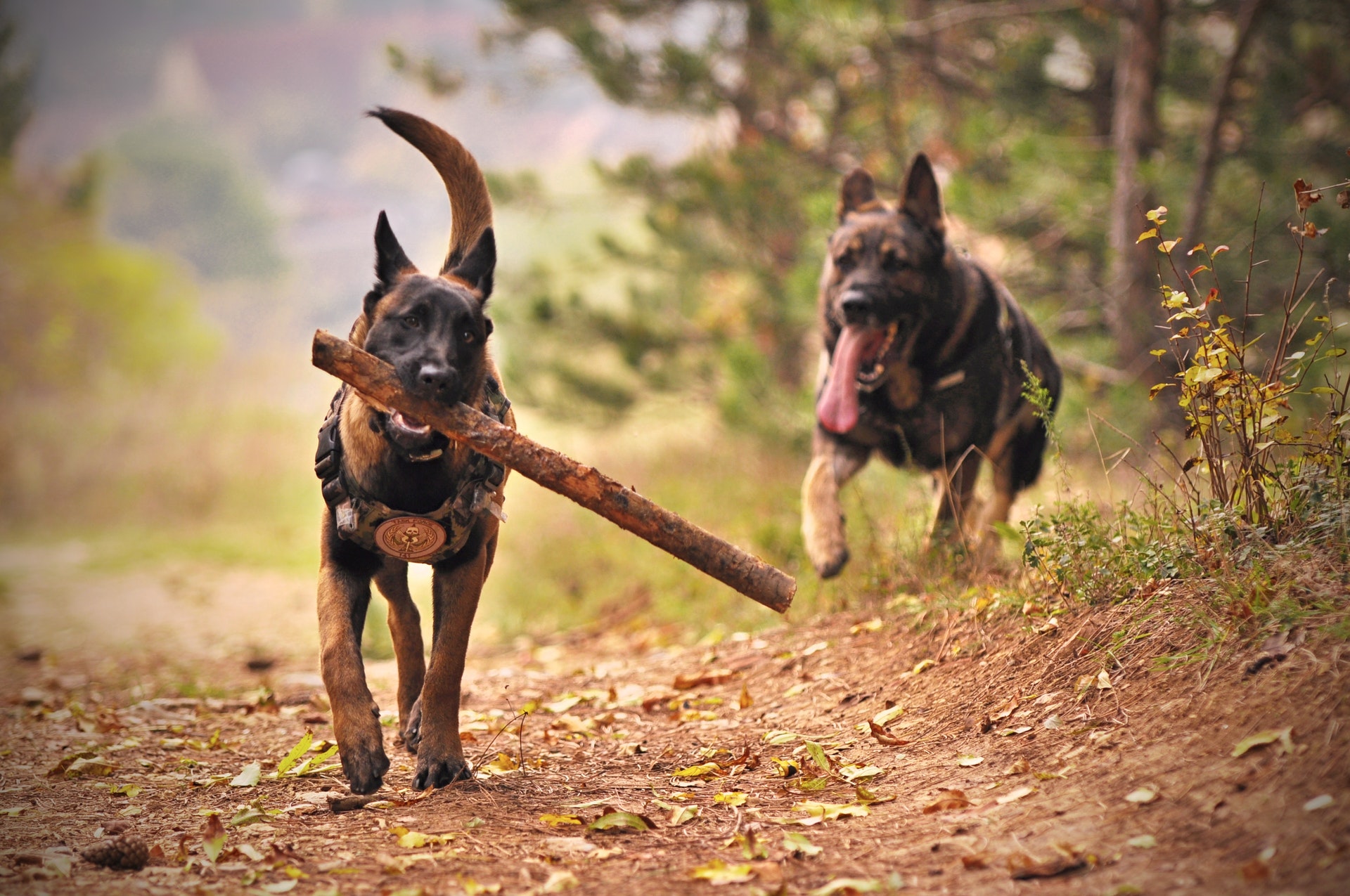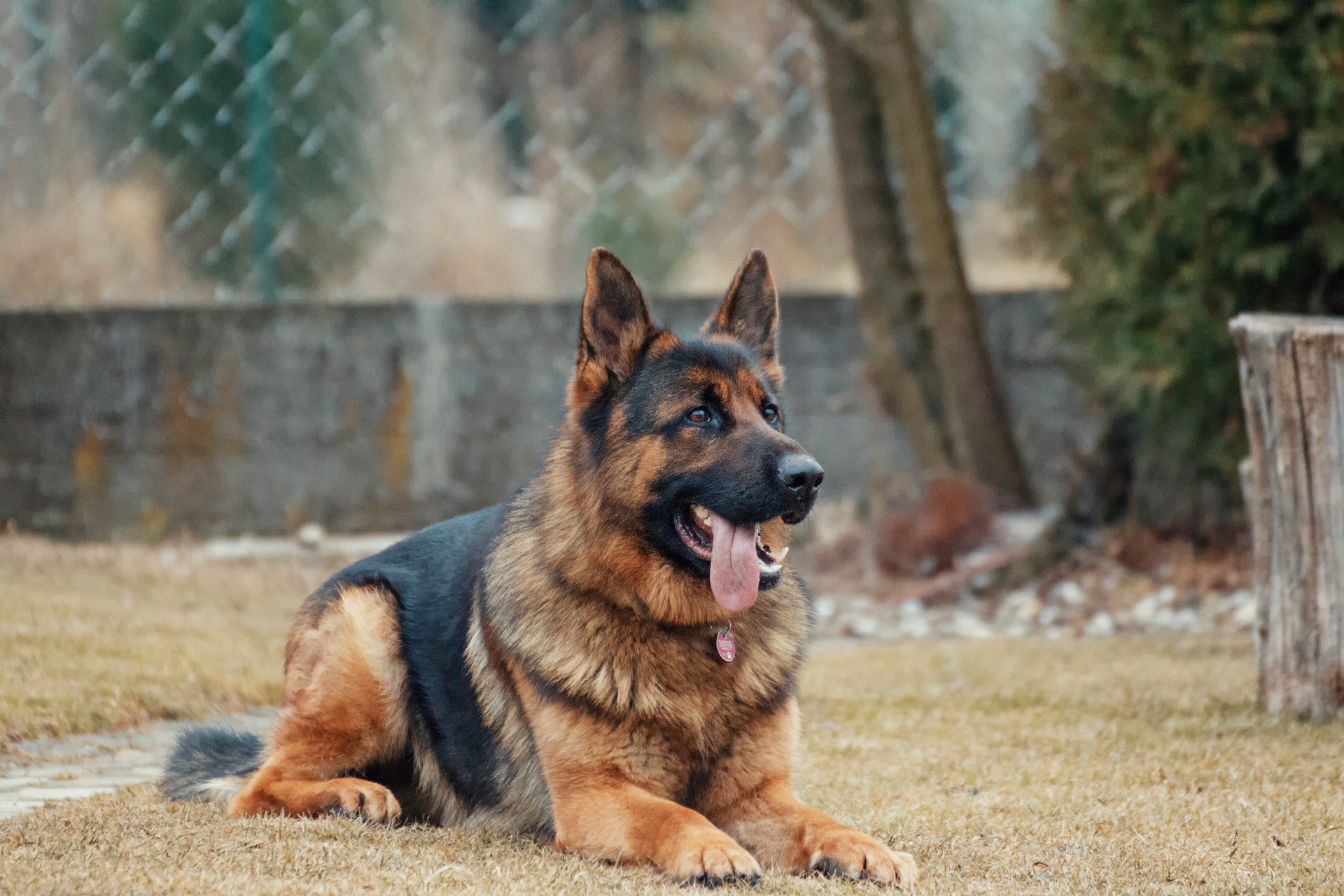If you’re looking for advice on German Shepherd obedience training then this is the most important page you’re ever going to read.
Because while obedience training is often thought of as a quick and easy way to get your dog to obey, it’s important to be aware of the pitfalls of getting it wrong!
Now, the problem with this particular breed is that they value hierarchy and the ‘pecking order’ above all else. Making it potentially tricky when it comes to establishing yourself as the pack leader.
Worse still, if they are not effectively kept in check. They can be prone to becoming bad-tempered and ill-disciplined.
Especially when their training is erratic or unsatisfactory.
You need to understand that German Shepherds require much more exercise and engagement than most other dogs. And limiting this can often spell disaster if you don’t give them out outlet to release their boundless energy.
However, if you can learn to successfully manage this extra demand. They can be a delight to train and develop.
Now, before we get into the do’s and don’t of obedience training, first a quick heads up.
While obedience training comes with its fair share of benefits, the real magic happens when you learn how to teach your German Shepherd how to remain calm and in control of their emotion.
Pair this with the critical element of learning how to establish yourself as the pack leader, and you’ve got the ultimate recipe for a well, behaved obedient dog that follows your every command.
This is why before you do anything else, I’d highly recommend checking out the Dog Calming Code from Dan Abdelnoor over at The Online Dog Trainer. (see video below)
Watch the video, implement the training Dan recommends, and you should see a huge improvement in your German Shepherd’s ability to listen, obey, and ultimately become highly responsive to you as the pack leader.
Here’s the link to take a look: Click Here To Discover How To Quickly Train A Well Behaved, Obedient German Shepherd Using A Simple, Highly Effective Training Technique That Takes Just Minutes A Day To Apply… Even If You’ve Tried & Failed Before!
(video will open in a new window)
Benefits Of Obedience Training
Most German Shepherds will take to their new family quickly.
As with all dogs, they will be curious and a little apprehensive being parted from their litter and mother for the first time. But they are a breed characterized by adaptability.
Any trainer will be glad to tell you that their receptiveness and natural curiosity makes them a delight to train.
And unless you are very unlucky or, more likely, just making mistakes, they will usually take to obedience training faster than most breeds.
The advantage of an obedient German Shepherd is that they can make for an outstanding family dog.
While famed for their defensive and protective qualities, they will socialize well into a receptive family who keeps them busy and reminds them when needed exactly who the boss is.
You need to get into the habit of using vocal instruction and hand instructions early and constantly reinforce lessons throughout the day. Because a bored German Shepherd will be far more likely to become a disruptive handful.
Positive & Negative Reinforcement Is Crucial
Knowing when to praise and tell off any dog is one thing any owner should invest time in learning.
Arguably, of all the breeds out there, German Shepherds rely on this far more than most.
Reinforcement is an essential tool for communicating with your dog. The idea is that they will grow to understand when they are being rewarded and for what reason.
In turn, they will consequently be enthusiastic towards repeating this behavior that earned them praise (or more likely a tasty snack!).
But how do we punish bad behavior effectively?
Firstly, you need to take control of every incident which may be construed as naughtiness or undesirable. But always appreciate that puppies/adolescents are going to make mistakes while undergoing training.
Do not ever consider shouting at your dog or physically losing your temper. As it can only take one occurrence to massively damage your relationship.
And in the case of receptive German Shepherds, this is even more likely.
For this reason, the best policy is to establish a ‘naughty doggy’ room that is isolated and will allow them to calm down.
Just a couple of minutes ought to be enough to reset their mood.
The real route for this course of action is to cement our position as the ‘Pack Alpha.’
As touched on above, German Shepherds can be prone to asserting authority (they have fangs and you do not!).
So how do you go about achieving this?
Establish Yourself As The Pack Leader
The first step to training a German Shepherd is to identify who will be the Alpha leader.
Once you have selected a member of your household, they must specifically take charge.
Failing to do so will likely just confuse your dog and even more, may lead him to believe that he’s the Top Player.
This simple mistake is why some people effectively lose control of their new German Shepherd quickly after accepting them into the home.
Don’t think that they are bothered or worried about being bossed around. Because the truth is, they actually thrive on structured hierarchies just as they would perform in the wild.
So how do we achieve this?
Well, it’s more about how we approach them in general than a specific training exercise.
You need to lead calmly and by example. Even the grumpiest German Shepherd will learn to appreciate and respect that.
The keyword here is consistency, and being sure never to give an inch.
As a good owner, you will of course, ensure that all your dog’s needs are met.
You’d be surprised at how easy it can be to turn even the grumpiest dog into an obedient member of the family by effectively following this little tip.
Now, at some stage, during their formative months/years. There is a good chance that they will try and exert more authority, especially once they have become fully matured.
So just be prepared for it and nip it in the bud right away. Get this right, and it’ll unlikely be an issue that repeats itself.

Leash Training Your German Shepherd
Anyone who has ‘enjoyed’ walking an unruly German Shepherd on the leash will know how hard they can pull.
So it’s important (for your long term sanity!) to start leash training quite early.
These are receptive dogs who grow fast, so between 14-16 weeks is an ideal time to start.
Now, before performing any leash training, it is sensible to have already begun with basic command training.
This will be necessary to control an adult and ought to be done anyway. The other advantage is that it will make leash work easier.
These are smart dogs who like to learn. But like any dog, they will sometimes foul up or seem stupid.
So just remember to keep cool, calm, and consistent at this stage.
Anyway…
Once they start to grasp the basics (use positive reinforcement methods for command training), there’s no need to delay the leash.
Here’s where the fun begins!
As working dogs, German Shepherds thrive on being exercised and active.
The best way to control their manners during walks is to make them excited and curious, basically distracting them from getting bored and pulling at their tie.
A good tip is to make the walking have an objective and lay it out over various stages. Make the goal a tasty treat at the end, but try to also use different routes and terrain.
Where possible, you should already have implemented a socialization plan that will expose them to other people, dogs, and environments.
Just remember that the more, the merrier.
Having a big and powerful dog walking nicely on the leash is a worthy reward for going out of your way to introduce them to factors outside of their comfort zone.
When walking your German Shepherd, try and maintain a steady pace.
Do not let him pull on the leash, and just as importantly, do not respond when it happens (and it will).
Instead, instruct them to sit and stand still until they do so.
Chances are that whatever is causing their overexcitement will soon be forgotten about.
Basically, the theory here is to be able to ‘pause’ good times when they misbehave. Your dog should also be rewarded for behaving well on their walks, but just make sure that they have truly earned it.
Teaching self-control is basically what leash training is all about. And German Shepherds usually tend to pick it up quickly.

Crate Training
Everyone is sometimes going to need to use their crate.
These are essential training aids, and 99% of dogs will eventually grow to love their cozy little den.
When it comes to training, the best policy is short and often.
Just 10 minutes to begin with repeated several times throughout the day ought to have them crate trained surprisingly quickly.
Remember that German Shepherds are no different from other breeds and are not appropriate to pen them in for longer periods than absolutely necessary.
The last thing you want is for them to dirty their bed. So try to limit unsupervised crating to a couple of hours until they have matured.
Except of course, when they choose to head there on their own (bedtimes are perfect).
Effective crate training is simply a matter of repetition.
So make sure you go out of your way to make their bedroom as comfortable as possible.
There’s nothing a German Shepherd likes more than a snuggly blanket and some toys/puzzles to enjoy.
Just be aware that it is normal for some dogs to bark and whine during their initial introductions to their crate. But it will pass!
Command Training
Once more, repetition makes all the difference. It is amazing how many owners seem shy about training commands.
The more you ask them to come, stay, sit, and so on. The quicker you will be on your way to a good and obedient dog.
Constant reinforcement can occur anywhere in the house and at any time of the day.
Here’s how…
- Find a suitable area where you wish him to stay.
- Place down a few treats and command them to sit down.
- This may take a few turns. But when they figure it out, reward them with praise and more treats.
- Take a few steps back and ask them to come. When they do so, reward them appropriately.
It can take dozens of repetitions to get this right, so try and perform this randomly throughout the day.
The objective here is having a dog who will come to you of their own free will because they understand what you are saying.
Use your imagination wherever possible.
These commands can be used when loading up the car, calling them for dinner, or even just putting them into their crate for a while.
The more they are utilized, the swifter the progress will be.
Just remember to be consistent and only reward obedience. And try to never provide unearned treats to a German Shepherd.
Final Thoughts On German Shepherd Obedience Training
One of the reasons why German Shepherds have always been so popular with certain owners is that once you ‘figure them out.’ You can train and instruct them to be extremely well behaved.
Of all the dogs in the world, few compare to this breed when it comes to truly prove that you will receive back what effort you put in.
Left to their own devices, they can prove to be difficult to train, and you need to establish that you control all the good/fun stuff and that you will not just give it away for free.
There is plenty of more recommended training activities that both you and your dog will enjoy mastering.
But if you use the principles highlighted above as a foundation for how to effectively perform. Then you’ll be looking at a very happy future with your German Shepherd.
Do you want to share your experience of training German Shepherds?
I’d love to hear your opinions, so go ahead and post your comments in the box below…
(video will open in a new window)

